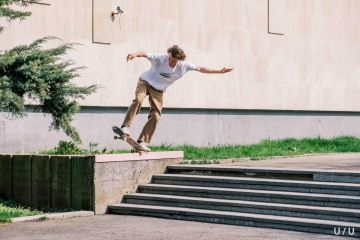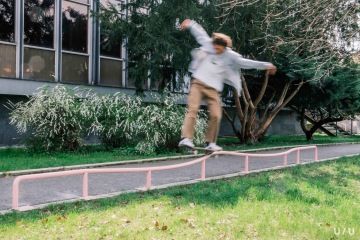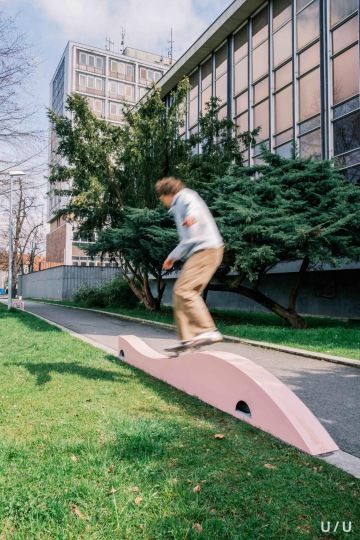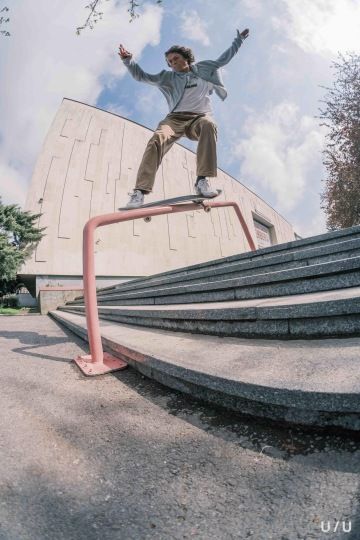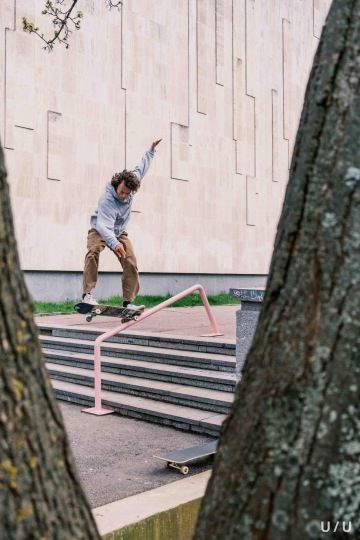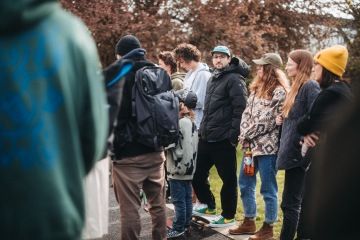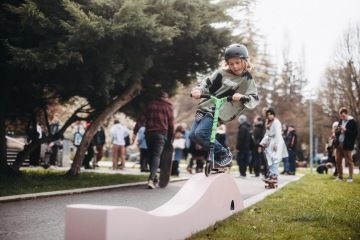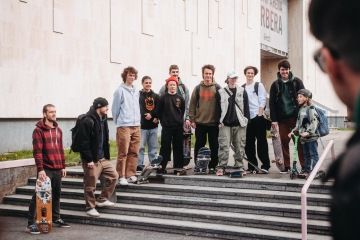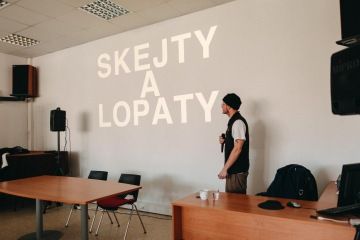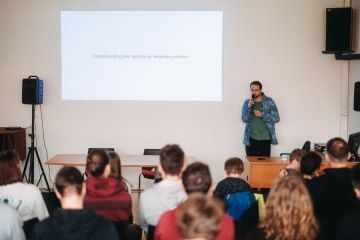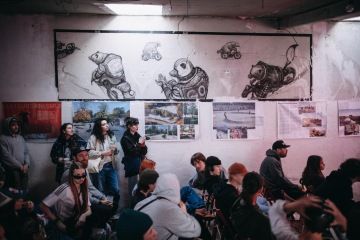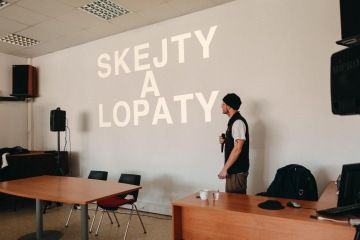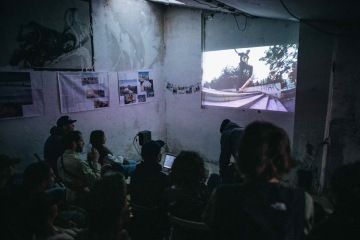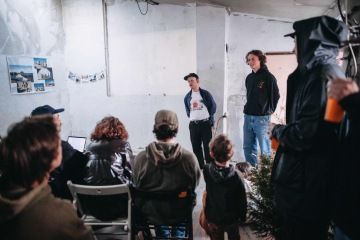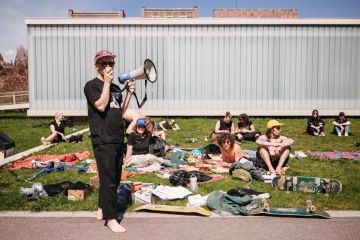Skateboarding belongs to the public space of the city. What benefits does it bring to its residents?
The space between the South Bohemian Science Library and KD Gerbera is filling up with people. Almost everyone has a skateboard in their hand and impatiently taps their feet. The first brave ones jump on it and ride out to explore the new features that grew here in mid-April thanks to the Skateholders event.
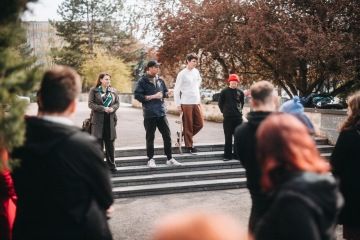
(c) Pavel Balek
Architects from Studio U / U created a plan tailored to this space. The light pink color of the elements, combined with the modernly reconstructed library on Lidická Street, creates a visually impressive whole. From a place that was originally only a passageway, it has become a place of gathering and spending free time.
The impulse for change came from the independent scene in Budweis
Urban outdoor sports, especially skateboarding, are activities that naturally connect public space, sports, and youth. The most prominent local skateboarding and cultural collective is Světadíl. Světadíl strives to improve the conditions for skateboarding and independent culture in the South Bohemian capital and its surroundings. They organize a skateboarding event as part of the Budějovický Majáles every year, where they highlight the potential of places in the public space of the city. It was Světadíl, representing the local skate scene, that was behind the Skateholders project.
Together with them and the nationally known architectural studio U / U, which focuses specifically on the connection between skateboarding and architecture, the city will seek suitable and as yet unused locations in public space in the future. They will transform them into places with high aesthetic value that will serve not only for skateboarding, but also for other urban sports. Just like in the realized project between the South Bohemian Science Library and KD Gerbera.
U/U Studio is made up of architects and engineers who share a passion for skateboarding. They like to spend their free time in public spaces, paying attention to details and having a sense of a given place. The solutions designed by the studio do not only serve skateboarding but also as a space that encourages meeting.
The Skateholders project has several parts. The first part, called Stakeholders #1, is successfully behind us. The program of the event was composed of the installation of new elements near the library, three lectures on skateboarding in different contexts, the premiere of a documentary about the skate scene in Budweis, and everything culminated in a race.
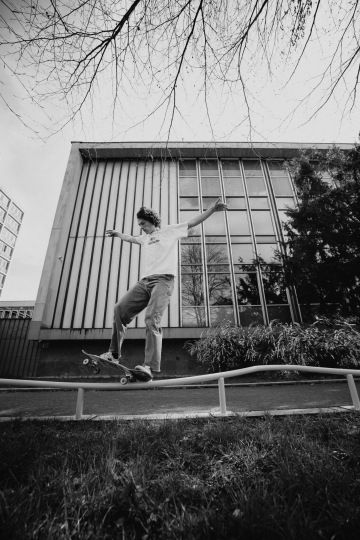
(c) Pavel Balek
Why is the project called Skateholders part of the candidacy of Budweis for the European Capital of Culture?
Breathing new life into forgotten places
Skateboarding is an activity that gives new functions to public spaces. Like other street activities (street art, graffiti, parkour, BMX, urbex...), skateboarding is part of our culture and therefore affects architecture and urbanism. Its support leads to the revitalization of spaces and thus to the creation of new interactions that improve the quality of life in the city.
Through architectural and artistic changes, Skateholders create space for urban outdoor sports and for the wider public. The aim is to supplement the existing and planned infrastructure and to make Budweis one of the European hubs of urban sports, where young people from all over Europe will meet.
Architect and co-founder of Studio U/U Martin Hrouda spoke about searching for the potential of places in his lecture on Skateholders. "There are playgrounds for children in public spaces, and outdoor gyms for adults are becoming more and more common. Do teenagers have a nice space to spend their free time? We found out that they mostly don't, and we want to change that."
During his presentation, Martin Hrouda showed photos of many places in Europe that have gained a new dimension thanks to their greater or smaller interventions. Underpasses on Vltavská in Prague, a sports complex in Cheb, urban park in Bratislava, and many others. The places are designed to serve the widest possible group of residents. In addition to skateable elements, they also have resting areas with comfortable seating and drinks. The main goal of architects is to create a place that will serve for meetings, interaction, and sports.
Skateboarding as a potential tool for education and social work.
As part of our candidacy for the European Capital of Culture, we aim to strengthen the potential positive impact of urban sports, including skateboarding, which has been shown to lead to the inclusion of young people, especially those at risk of social exclusion, as well as strengthening their healthy lifestyles. The installation of art-sports elements is only the first part of the planned project included in our candidacy.
The second phase of our project is the "Skateholders FORUM", which aims to connect with the global community of organizations using skateboarding for education and development assistance/social work. What are his experiences in Mozambique and Zambia? Intense. Czech Television made a documentary about Skate World Better's activities called Skejty a Lopaty, which premiered on May 4. "Of course, building a skatepark in Africa is not enough. We always connect with local organizations that take care of the newly created place. They have skateboards that they lend. At the same time, we build skateparks to function multifunctionally. We leave a space where lectures or other educational programs can take place," Martin Loužecký, founder of the Skate World Better nonprofit project, adds at the end of his lecture on skateboarding in Africa.
Inclusion of skateboarding in everyday life.
The last part of the Budweis candidacy project, called "Skateholders ŠKOLA", focuses on a skateboarding-educational program with an emphasis on better integration of children and young people, especially from socio-economically disadvantaged families.
In the years 2024-2028, volunteer projects of so-called social sports will gradually be introduced. Erasmus+ sports projects will focus on connecting with corresponding activities abroad, including Germany or the Middle East, where such initiatives are very successful.
Jakub Novotný, who has long been involved in topics such as enriching cultural and sporting events and improving the integration of socially disadvantaged children and young people, spoke more about the Skateholders project vision. The project aims to encompass all of these topics.
Several specific paths lead to this goal, including cooperation with local institutions and organizations such as schools, leisure and low-threshold organizations, or sports and cultural associations. "The skatepark operates as an environment where it is normal for girls to have the same right to use the space as boys," Novotný names one of the impacts of skateboarding on society in the Middle East. "Non-profit organizations have the most influence on motivating children through skateboarding, and it is not just because of that that this sport is no longer associated with vandalism and curb destruction in the eyes of the public," Novotný adds.
(c) Pavel Balek
